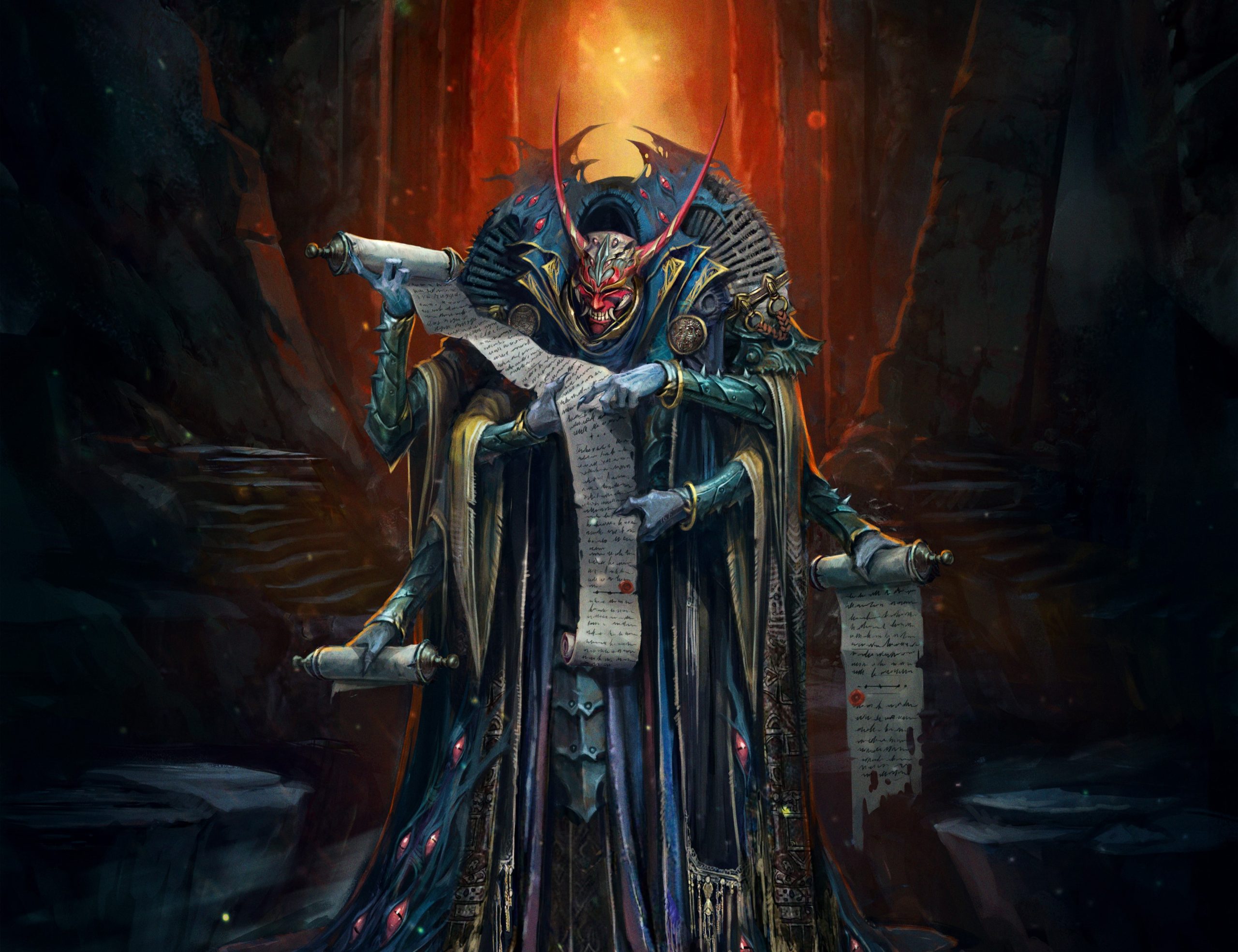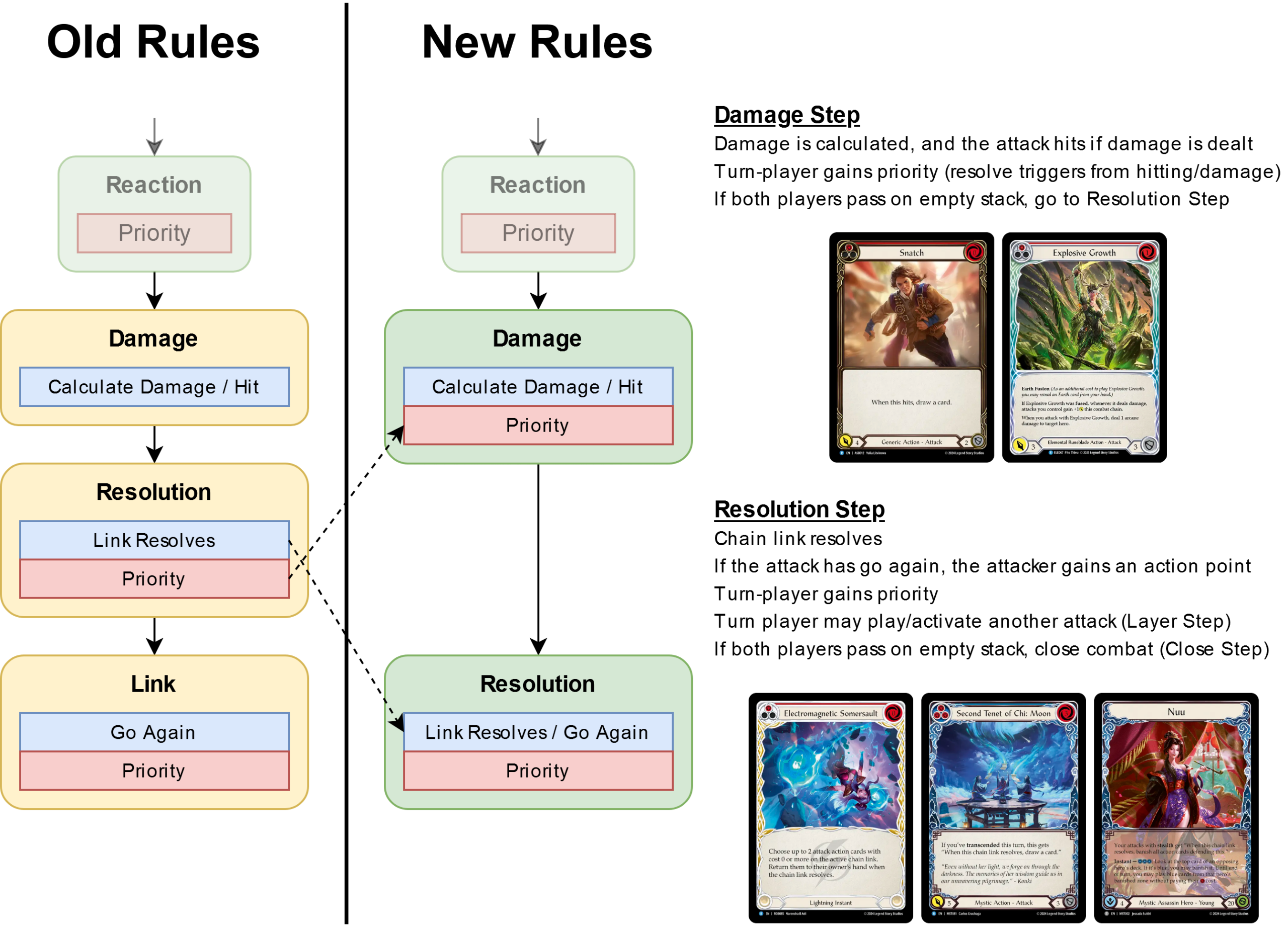With The Hunted’s release approaching closer, a season of change is on the horizon. New set releases present opportunities to expand the ways the game is played, but also challenge us to continuously improve on existing rules and policies that support the game, its tournaments, and players all around the world. The Rules and Policy Team is back to discuss some upcoming changes to Flesh and Blood’s existing rules and policy documentation that will be effective with The Hunted. Joshua Scott and Niccolo Paqueo are here to help you mark down what’s new about combat, naming, and elimination rounds.
TL;DR There are 3 major rules and policy changes that you need to be aware of:
- The Damage, Resolution, and Link steps of combat are being simplified from three steps to two steps: damage and resolution.
- Players may name any official Flesh and Blood card, not just the names of cards that are only legal for their format.
- Policies for elimination rounds are being adjusted to ensure draws will lead to a definitive match conclusion.
These changes will come into effect with the release of The Hunted on January 31, 2025.

Changes to Combat
The later steps of combat are being updated to simplify the rules and make some interactions more intuitive. Previously, there were three steps that occurred after the Reaction Step of combat:
- Damage Step – damage is calculated, no priority
- Resolution Step – link resolves, then priority
- Link Step – go again resolves, then priority
Moving forward, the steps after the Reaction Step will occur as such:
- Damage Step – damage is calculated, then priority
- Resolution Step – link resolves, go again resolves, then priority

Functionally, this ONLY changes interactions that would occur as a result of the chain link resolving (i.e. effects that say “when the chain link resolves”). This essentially aligns the process of the chain link officially resolving and go again being checked on the attack.
This change primarily affects Electromagnetic Somersault. Players may now play and resolve Electromagnetic Somersault after damage is dealt (during the Damage Step) and be able to return cards when the chain link resolves. This effectively allows a turn player to decide whether or not to play Electromagnetic Sommersault after damage is dealt without missing the window to return the card to their hand.
Tyler attacks Nic with a Lightning Surge from arsenal. Nic does not defend or prevent any damage. Nic is dealt 4 damage, and during the Damage Step of combat Tyler plays and resolves Electromagnetic Somersault choosing their Lightning Surge. Both players pass on the empty stack, the Damage Step ends and the Resolution Step begins. The chain link resolves, triggering Electromagnetic Somersault’s effect, and Tyler gains 1 action point from the go again on Lightning Surge. Then the trigger resolves, and Lighting Surge returns to Tyler’s hand. During the same Resolution Step, Tyler may play the Lightning Surge again as the next attack on the same combat chain.
Other notable changes include: Nuu; Nuu, Alluring Desire; Second Tenet of Chi: Moon; and some minor inconsequential interactions involving Double Strike, Send Packing, Virulent Touch, and cards with wager. Previously, the on-chain-link-resolution triggered effects of these cards could be ordered along with other on-hit and on-damage triggered effects. Now, on-hit and on-damage triggered effects ALWAYS occur (during the Damage Step) before any on-chain-link-resolution triggered effects (during the Resolution Step).
In addition, there are some old printings of Salvage Shot and Over Loop that mention “If this hits, [….] when the chain link resolves” – these cards will remain simple “on-hit, do the thing” as per their true-text, instead of creating another delayed triggered effect. If in doubt, please check the most up-to-date text in our official card database.
Naming Cards
Giving cards different names was governed by a simple rule: when an effect instructed a player to name a card, players could only name an official Flesh and Blood card that was legal for the format they are playing in.
With the September 4, 2024 Banned and Restricted Announcement came a full ban of Bonds of Ancestry in the Classic Constructed and Blitz formats. This impacted Dishonor, as its abilities looked for Bonds of Ancestry as a necessary puzzle piece to satisfy its conditional effects. With the previous naming rules in place, players were unable to leverage other creative means offered by cards, such as Mask of Many Faces, to Dishonor their opponents.
With the release of Retrace the Past in The Hunted, this naming rule will be broadened to include any card. Specifically, when an effect instructs a player to name a card, players can name any official Flesh and Blood card (from the date of its release). Not only can players name cards that are playable in their format, but even banned cards and special-use promos will be fair game to be named.
Tyler is playing as Katsu against Nic in Classic Constructed format. Tyler has attacked with Surging Strike, Descendent Gustwave, and is now attacking with Retrace the Past. In the Attack Step, Retrace the Past triggers and resolves, and Tyler names the currently banned card “Bonds of Ancestry”, which causes Retrace the Past to get that name. Finally, Tyler attacks Nic with Dishonor which has +2{p} from its combo ability, as a card with the name Bonds of Ancestry was the last attack this combat chain. If the Dishonor hits, the if-conditional would be met as Tyler currently controls cards with the names Surging Strike, Descendent Gustwave, and Bonds of Ancestry.
Tiebreaker Games
While it hasn’t officially occurred yet, there will eventually come a time players in a high-stakes, Top 8 match will come to a stalemate or deadlock, and judges will have to follow procedure to ensure that a winner is properly determined. Unlike matches in swiss rounds, draws are not acceptable results, as we can only progress a single player from each match to the next elimination round.
The previous procedure was to have the players continuously play games until a winner emerged. However, this is dangerous territory, as it theoretically allows players to indefinitely prolong a match, whether intentionally or not. In Flesh and Blood, we do not force the players to take actions; we only determine the results of games based on the actions they do or do not take.
Moving forward, we’re adapting our policy to ensure that elimination matches come to a definite conclusion in a timely manner for the benefit of not only the players, but everyone involved. First, let’s establish what a can cause a draw in a game:
- Intentional – When players AGREE to draw a game. Typically because they do not want to play and it doesn’t affect their personal standings.
- Deadlock – When players DO NOT WANT to progress the game. Typically because if they progress the game, they will lose.
- Stalemate – When players CANNOT progress the game. Typically because they lack the cards to progress the game.
If the match of an elimination round (i.e. Top 8) would end in a draw, follow these steps:
- Step 1 – The players are warned that if no progress is made, the winner of the game will be determined by the highest life total. If no player makes an action to progress the game state towards a result other than a draw, go to Step 2.
- Step 2 – The winner is the player whose hero has the highest life total in the current game. If neither hero has a higher life total, go to Step 3.
- Step 3 – Players start a new tiebreaker game with 4 turns total (2 turns per player). After 4 turns, go to Step 4.
- Step 4 – The tiebreaker game continues until one hero has a higher life total and the winner of the match is that hero’s player. If the tiebreaker game ends in a draw, go to Step 5.
- Step 5 – The winner of the match is the player that had the highest standing before the match began.
The key principles of this new policy are to give the players the opportunity to continue the game before the match is determined by life totals, as well as having an additional opportunity to determine a winner through a tiebreaker game, and finally having a catch-all that determines a winner in the unlikely scenario that both players continue to draw.
Note that this tiebreaker policy ONLY applies to elimination rounds (i.e. Top 8). If players draw a game in a swiss round and the round time hasn’t expired, they may play another game to determine the outcome of the match.






